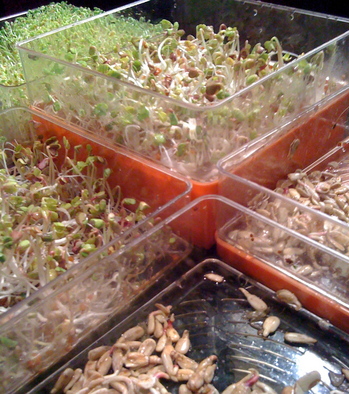As easy as ... sprouting

Sunflower sprouting in the foreground, radish in the middle, and red clover growing in the back.
Corinna Borden | Contributor
As consumers learn about the world of superfoods, companies jump on the opportunity to put denatured Omega 3 into our yogurt. I agree with a nutritionist from the Center for Science in the Public Interest (despite the fact that her organization sounds Orwellian) when she says the whole thing is “very confusing.”
I am all about making my life less confusing, which is why I love to sprout.
Last year three things happened for me simultaneously: I read Animal, Vegetable, Miracle, the economy nosedived, and gas prices were very high. I started ranting about food miles, carbon footprints, and our budget. My husband, hoping to placate my rants, gave me a sprouter for my birthday. I was so enamored that I quickly bought two more.
The reason I bought two more is because I wanted to be able to eat sprouts for my veggie bowl everyday. In order to have a constant supply I quickly learned the importance of staggering the growing of the seeds. Certain seeds take a long time (for example, I’ve found wheatgrass, sunflower, and broccoli take about 6-8 days to really be something). Certain seeds don’t (red clover, alfalfa, and radish take about 4-6). I am constantly washing out and starting new seeds to make sure my supply is fairly regular.
My system of sprouting is extremely easy. I soak the seeds overnight in water. Dump them onto the sprouting tray and then rinse them morning and night. In a few days I eat them and start over. Some seeds my be duds and turn into mush instead of sprouting, in which case I dump the healthy ones out, clean out the duds, and put the healthy ones back in. That’s it. Easy as pie.

I bought my wheatgrass seeds from Shelter's Organic Produce at the Farmers Market, out of Homer, MI.
Corinna Borden | Contributor
Last but not least, what do you do with sprouts and how do they taste? I love the nutty flavor of sunflower sprouts stir-fried, in a salad, or eaten plain as a snack. Radish sprouts have a peppery bite that kicks you and is nice to put on a grilled cheese to cut through the fat. Alfalfa and red clover are very delicate and I only eat them raw. I find wheatgrass too stringy to eat in a salad, so that one goes directly into the juicer.
All I heard yesterday on the radio was commentary from the Copenhagen environmental summit. While debate rages in the netherworld of potentialities, maybes, and “one day,” it is nice to know I can do something simple, nutritious, and delicious now.
Drop me a line! Check out my website! Post a comment and start the conversation rolling!


Comments
Wolverine3660
Tue, Dec 8, 2009 : 3:40 p.m.
I grew up in one of the north-eastern States in India. We ate sprouted garbanzos and mung beans almost every day. Actually we took both kinds of sprouted beans, rinsed them, added finely chopped ginger, some lemon juice and salt to taste and ate them.